Distribution, Transfer, and Health Risk of Organochlorine Pesticides in Soil and Water of the Huangshui River Basin
Abstract
:1. Introduction
2. Materials and Methods
2.1. Samples Collection
2.2. Chemicals
2.3. Extraction and Analysis
2.4. Method Validation
2.5. OCPs Transport Modeling
2.6. Health Risk Assessment
2.7. Data Analysis
3. Result and Discussion
3.1. Occurrence of OCPs in Soil and Water Samples
3.2. The Sources and Compositions of OCPs
3.2.1. The Sources and Compositions of DDTs
3.2.2. The Sources and Compositions of HCHs
3.3. Environmental Transport of OCPs
3.4. Carcinogenic Risk Assessment of OCPs
4. Conclusions
Supplementary Materials
Author Contributions
Funding
Institutional Review Board Statement
Informed Consent Statement
Data Availability Statement
Conflicts of Interest
References
- Almasi, H.; Takdastan, A.; Jaafarzadeh, N.; Babaei, A.A.; Birgani, Y.T.; Cheraghian, B.; Saki, A.; Jorfi, S. Spatial distribution, ecological and health risk assessment and source identification of atrazine in Shadegan international wetland, Iran. Mar. Pollut. Bull. 2020, 160, 111569. [Google Scholar] [CrossRef]
- Cairenzhuoma. Integrated management measures for grassland insect pests in alpine pasture areas of Qinghai. Farming Feed 2010, 7, 82–83. [Google Scholar]
- Cao, F.; Li, Z.; He, Q.; Lu, S.; Qin, P.; Li, L. Occurrence, spatial distribution, source, and ecological risk assessment of organochlorine pesticides in Dongting Lake, China. Environ. Sci. Pollut. Res. 2021, 28, 30841–30857. [Google Scholar] [CrossRef]
- Cao, H.; Gong, Z.; Cao, J.; Li, B.; Xu, F.; Tao, S. Evaluating the Fate of Y-HCH Using Fugacity Model in Tianjin Environment. Chin. J. Environ. Sci. 2003, 24, 77–81. [Google Scholar]
- Dong, J.; Gao, H.; Wang, S.; Yao, H.; Ma, M. Simulation of the transfer and fate of HCHs since the 1950s in Lanzhou, China. Ecotoxicol. Environ. Saf. 2009, 72, 1950–1956. [Google Scholar] [CrossRef]
- Dong, J.; Wang, S.; Shang, K. Simulation of the long-term transfer and fate of DDT in Lanzhou, China. Chemosphere 2010, 81, 529–535. [Google Scholar] [CrossRef]
- Gai, N.; Pan, J.; Tang, H.; Tan, K.-Y.; Chen, D.-Z.; Zhu, X.-H.; Lu, G.-H.; Chen, S.; Huang, Y.; Yang, Y.-L. Selected organochlorine pesticides and polychlorinated biphenyls in atmosphere at Ruoergai high altitude prairie in eastern edge of Qinghai-Tibet Plateau and their source identifications. Atmos. Environ. 2014, 95, 89–95. [Google Scholar] [CrossRef]
- Hu, Y.; Qi, S.; Zhang, J.; Tan, L.; Zhang, J.; Wang, Y.; Yuan, D. Assessment of organochlorine pesticides contamination in underground rivers in Chongqing, Southwest China. J. Geochem. Explor. 2011, 111, 47–55. [Google Scholar] [CrossRef]
- Kafaei, R.; Arfaeinia, H.; Savari, A.; Mahmoodi, M.; Rezaei, M.; Rayani, M.; Sorial, G.A.; Fattahi, N.; Ramavandi, B. Organochlorine pesticides contamination in agricultural soils of southern Iran. Chemosphere 2020, 240, 124983. [Google Scholar] [CrossRef]
- Kirchner, M.; Faus-Kessler, T.; Jakobi, G.; Levy, W.; Henkelmann, B.; Bernhoeft, S.; Kotalik, J.; Zsolnay, A.; Bassan, R.; Belis, C.; et al. Vertical distribution of organochlorine pesticides in humus along Alpine altitudinal profiles in relation to ambiental parameters. Environ. Pollut. 2009, 157, 3238–3247. [Google Scholar] [CrossRef]
- Li, J.; Li, F.; Liu, Q. Sources, concentrations and risk factors of organochlorine pesticides in soil, water and sediment in the Yellow River estuary. Mar. Pollut. Bull. 2015, 100, 516–522. [Google Scholar] [CrossRef]
- Li, J.; Zhang, G.; Qi, S.; Li, X.; Peng, X. Concentrations, enantiomeric compositions, and sources of HCH, DDT and chlordane in soils from the Pearl River Delta, South China. Sci. Total Environ. 2006, 372, 215–224. [Google Scholar] [CrossRef]
- Li, Q.; He, C.; Ma, Z.; Ma, L.; Zhaxi, Z.; Wang, Y.; Jin, J. Levels and Distribution of Organochlorine Pesticides and Dioxin-Like Polychlorinated Biphenyls in Atmospheric Particulates in Xining and Tianjun, Qinghai Province, China. Environ. Sci. 2015, 36, 402–407. [Google Scholar]
- Lin, T.; Hu, L.; Shi, X.; Li, Y.; Guo, Z.; Zhang, G. Distribution and sources of organochlorine pesticides in sediments of the coastal East China Sea. Mar. Pollut. Bull. 2012, 64, 1549–1555. [Google Scholar] [CrossRef]
- Lin, T.; Hu, Z.; Zhang, G.; Li, X.; Xu, W.; Tang, J.; Li, J. Levels and Mass Burden of DDTs in Sediments from Fishing Harbors: The Importance of DDT-Containing Antifouling Paint to the Coastal Environment of China. Environ. Sci. Technol. 2009, 43, 8033–8038. [Google Scholar] [CrossRef]
- Lin, T.; Li, J.; Xu, Y.; Liu, X.; Luo, C.; Cheng, H.; Chen, Y.; Zhang, G. Organochlorine pesticides in seawater and the surrounding atmosphere of the marginal seas of China: Spatial distribution, sources and air-water exchange. Sci. Total Environ. 2012, 435, 244–252. [Google Scholar] [CrossRef]
- Liu, Q.; Tian, S.; Jia, R.; Liu, X. Pollution characteristics and ecological risk assessment of HCHs and DDTs in estuary wetland sediments from the Bohai Bay, North China. Environ. Sci. Pollut. Res. 2017, 24, 26967–26973. [Google Scholar] [CrossRef]
- Ma, J.; Pan, L.; Yang, X.; Liu, X.; Tao, S.; Zhao, L.; Qin, X.; Sun, Z.; Hou, H.; Zhou, Y. DDT, DDD, and DDE in soil of Xiangfen County, China: Residues, sources, spatial distribution, and health risks. Chemosphere 2016, 163, 578–583. [Google Scholar] [CrossRef]
- Paasivirta, J.; Sinkkonen, S.; Mikkelson, P.; Rantio, T.; Wania, F. Estimation of vapor pressures, solubilities and Henry’s law constants of selected persistent organic pollutants as functions of temperature. Chemosphere 1999, 39, 811–832. [Google Scholar] [CrossRef]
- Peng, J.; Liu, Z.; Liu, Y.; Wu, J.; Han, Y. Trend analysis of vegetation dynamics in Qinghai-Tibet Plateau using Hurst Exponent. Ecol. Indic. 2012, 14, 28–39. [Google Scholar] [CrossRef]
- Qu, C.; Albanese, S.; Lima, A.; Li, J.; Doherty, A.L.; Qi, S.; De Vivo, B. Residues of hexachlorobenzene and chlorinated cyclodiene pesticides in the soils of the Campanian Plain, southern Italy. Environ. Pollut. 2017, 231, 1497–1506. [Google Scholar] [CrossRef]
- Sun, H.; Qi, Y.; Zhang, D.; Li, Q.X.; Wang, J. Concentrations, distribution, sources and risk assessment of organohalogenated contaminants in soils from Kenya, Eastern Africa. Environ. Pollut. 2016, 209, 177–185. [Google Scholar] [CrossRef]
- Tang, D.; Liu, X.; He, H.; Cui, Z.; Gan, H.; Xia, Z. Distribution, sources and ecological risks of organochlorine compounds (DDTs, HCHs and PCBs) in surface sediments from the Pearl River Estuary, China. Mar. Pollut. Bull. 2020, 152, 110942. [Google Scholar] [CrossRef]
- Tasdemir, Y.; Salihoglu, G.; Salihoglu, N.K.; Birgul, A. Air-soil exchange of PCBs: Seasonal variations in levels and fluxes with influence of equilibrium conditions. Environ. Pollut. 2012, 169, 90–97. [Google Scholar] [CrossRef]
- Tsui, T.-H.; van Loosdrecht, M.C.M.; Dai, Y.; Tong, Y.W. Machine learning and circular bioeconomy: Building new resource efficiency from diverse waste streams. Bioresour. Technol. 2023, 369, 128445. [Google Scholar] [CrossRef]
- Wang, G.; Lu, Y.; Wang, T.; Zhang, X.; Han, J.; Luo, W.; Shi, Y.; Li, J.; Jiao, W. Factors Influencing the Spatial Distribution of Organochlorine Pesticides in Soils surrounding Chemical Industrial Parks. J. Environ. Qual. 2009, 38, 180–187. [Google Scholar] [CrossRef]
- Wang, X.P.; Yao, T.D.; Cong, Z.Y.; Yan, X.L.; Kang, S.C.; Zhang, Y. Distribution of persistent organic pollutants in soil and grasses around Mt. Qomolangma, China. Arch. Environ. Contam. Toxicol. 2007, 52, 153–162. [Google Scholar] [CrossRef]
- Wen, H.; Qi, S.; Li, J. A study of the environmental behavior of organochlorine pesticides using multimedia environmental models. Hydrogeol. Eng. Geol. 2009, 36, 104–108. [Google Scholar]
- Wu, C.; Xiong, X.; Huang, X.; Xing, X.; Liu, J. Occurrence and distribution of organochlorine pesticides and polycyclic aromatic hydrocarbons in surface sediments from Qinghai Lake, northeast Qinghai-Tibet plateau, China. J. Great Lakes Res. 2014, 40, 675–683. [Google Scholar] [CrossRef]
- Xing, X.; Qi, S.; Odhiambo, J.O.; Zhang, Y.; Liu, Y. Influence of environmental variables on spatial distribution of organochlorine pesticides in Sichuan, West China. Environ. Earth Sci. 2009, 59, 215–222. [Google Scholar] [CrossRef]
- Zhang, G.; Parker, A.; House, A.; Mai, B.X.; Li, X.D.; Kang, Y.H.; Wang, Z.S. Sedimentary records of DDT and HCH in the Pearl River Delta, South China. Environ. Sci. Technol. 2002, 36, 3671–3677. [Google Scholar] [CrossRef] [PubMed]
- Zhang, H.; Gao, R.; Huang, Y.; Jia, X.; Jiang, S. Spatial variability of organochlorine pesticides (DDTs and HCHs) in surface soils from the alluvial region of Beijing, China. J. Environ. Sci. 2007, 19, 194–199. [Google Scholar] [CrossRef]
- Zhang, Y. An Empirical Study on the Relationship betweenAgricultural Non-point Source Pollution and Economic Development in the Huangshui River Basin. Master’s Thesis, Qinghai University, Xining, China, May 2019. [Google Scholar]
- Zhao, Z.; Zeng, X.; Zhao, L.; Jiao, X.; Chen, Q. Distribution and Characteristics of Organochlorine Pesticides in Soils from Conservation Areas of the Miyun Reservoir. J. Basic Sci. Eng. 2020, 28, 805–816. [Google Scholar]
- Zheng, X.; Liu, X.; Liu, W.; Jiang, G.; Yang, R. Concentrations and source identification of organochlorine pesticides (OCPs) in soils from Wolong Natural Reserve. Chin. Sci. Bull. 2009, 54, 743–751. [Google Scholar] [CrossRef]
- Zhou, Y.; Jing, J.; Yu, R.; Zhao, Y.; Gou, Y.; Tang, H.; Zhang, H.; Huang, Y. Distribution of pesticide residues in agricultural topsoil of the Huangshui catchment, Qinghai Tibet Plateau. Environ. Sci. Pollut. Res. 2022, 30, 7582–7592. [Google Scholar] [CrossRef] [PubMed]
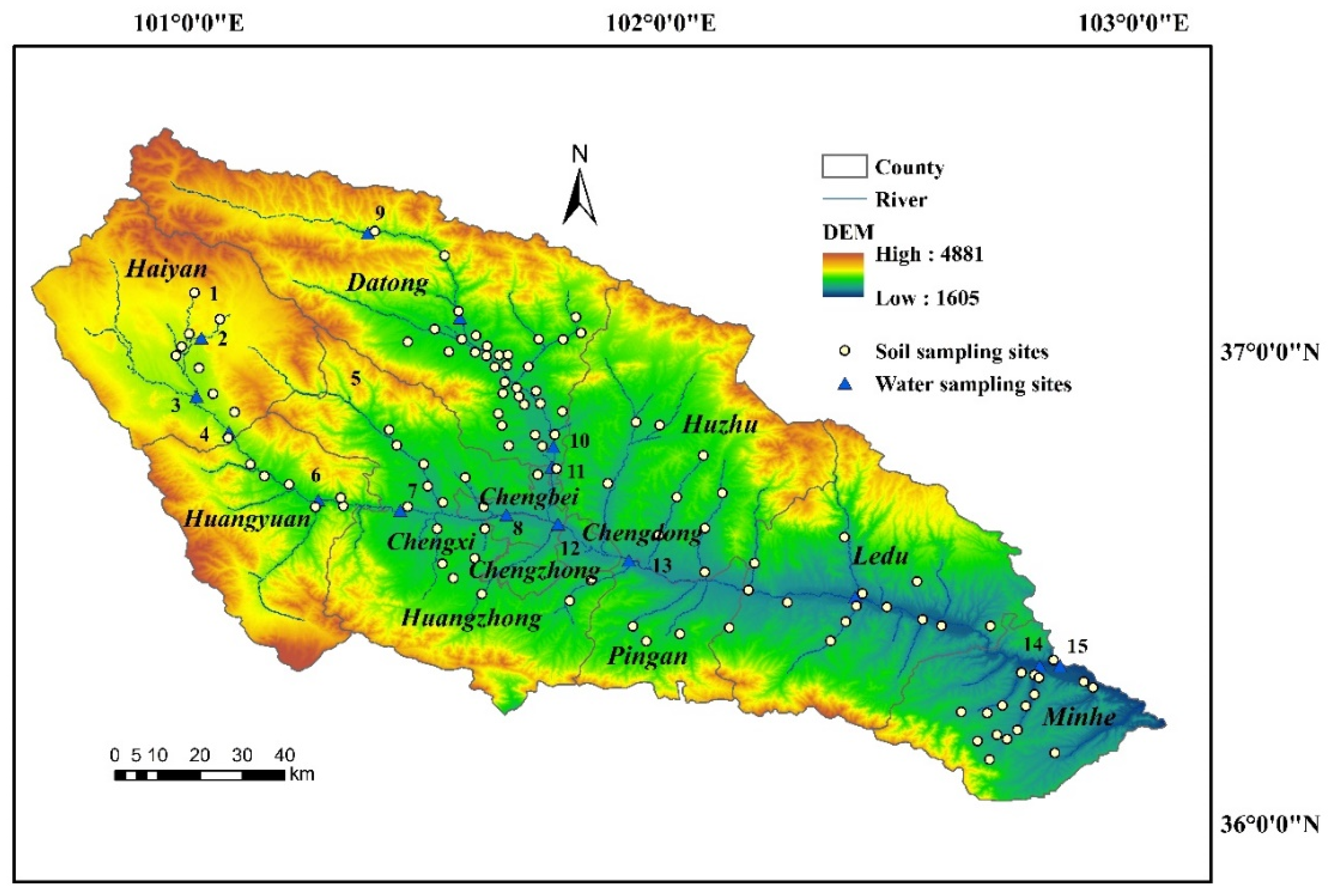
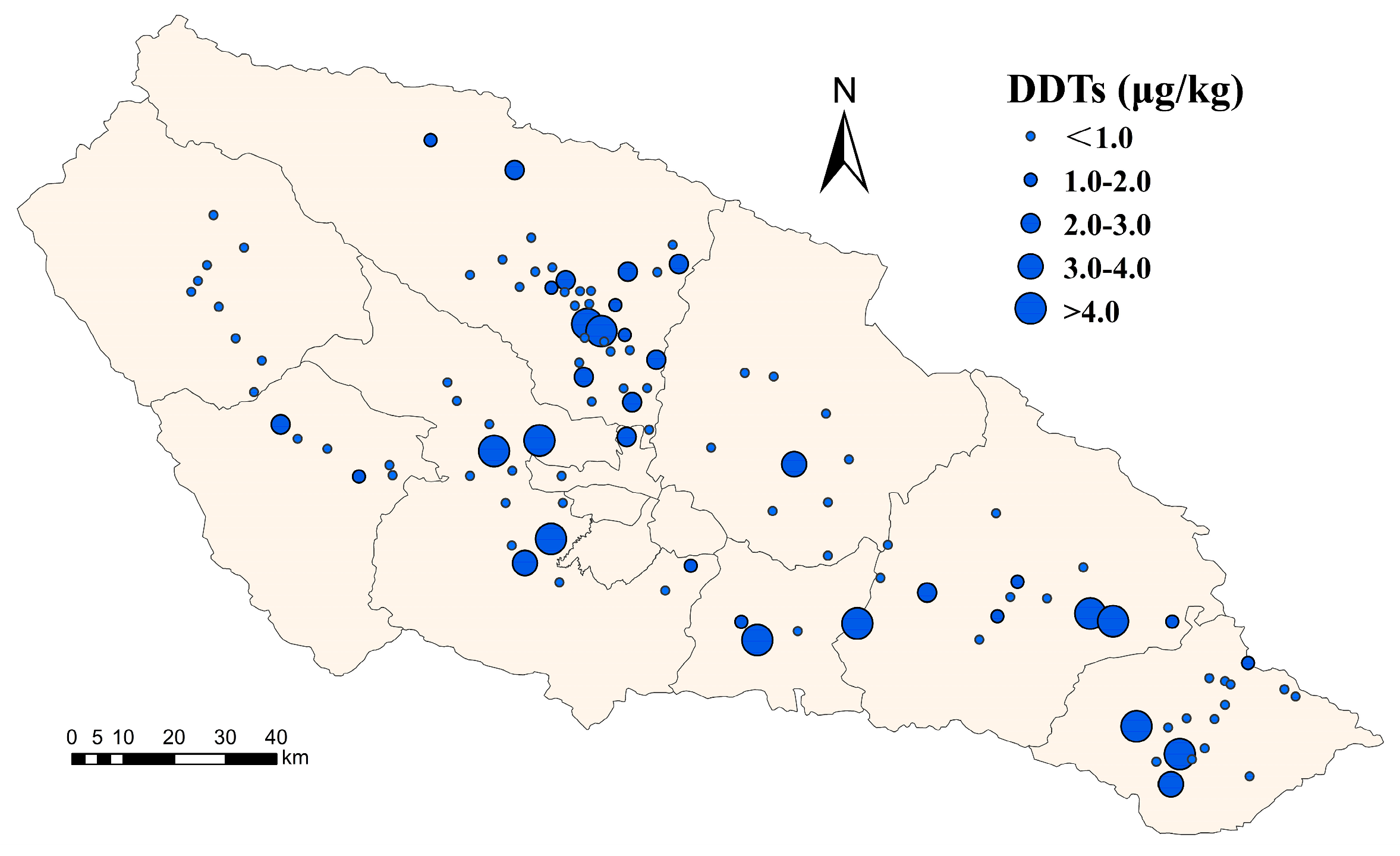

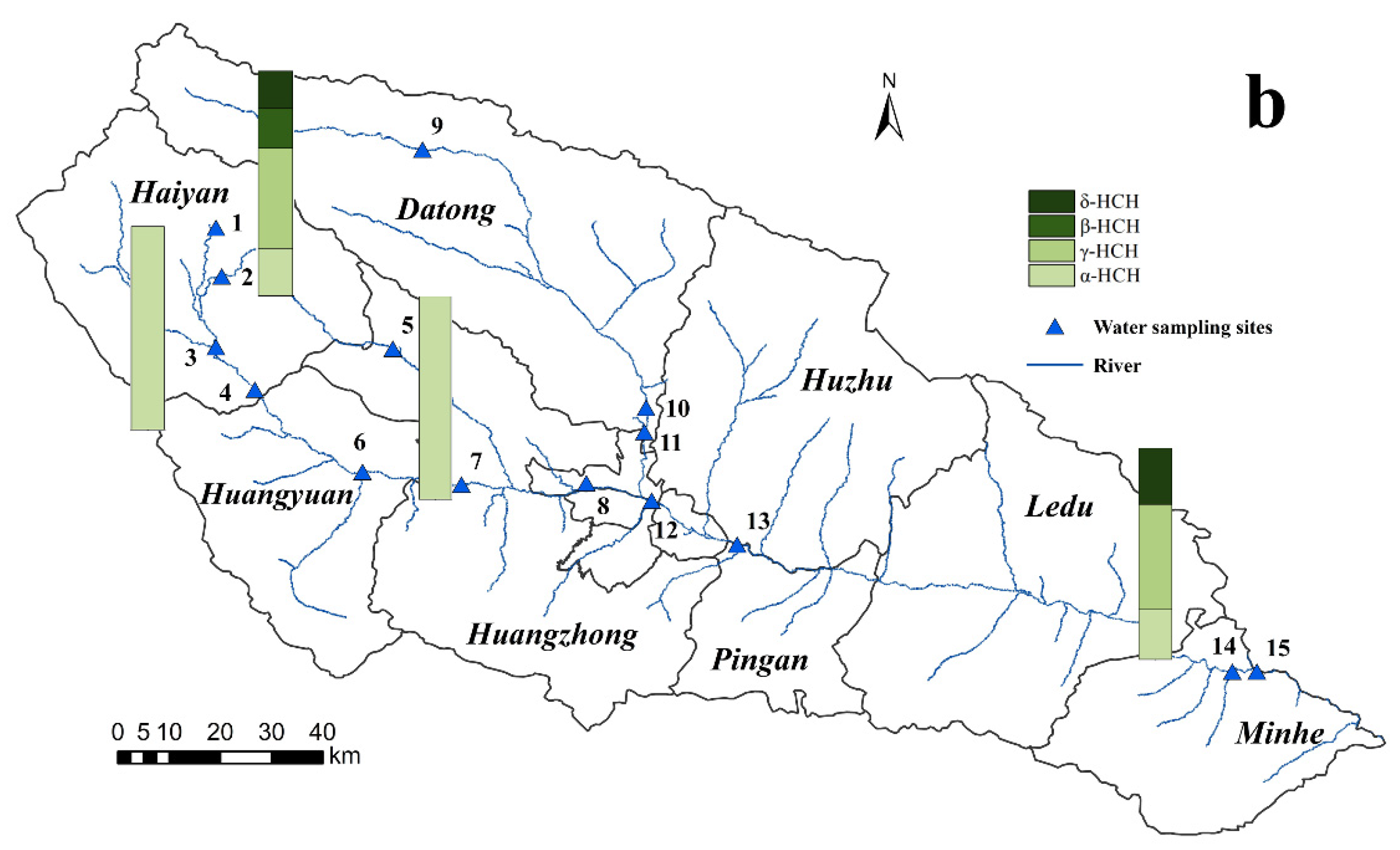


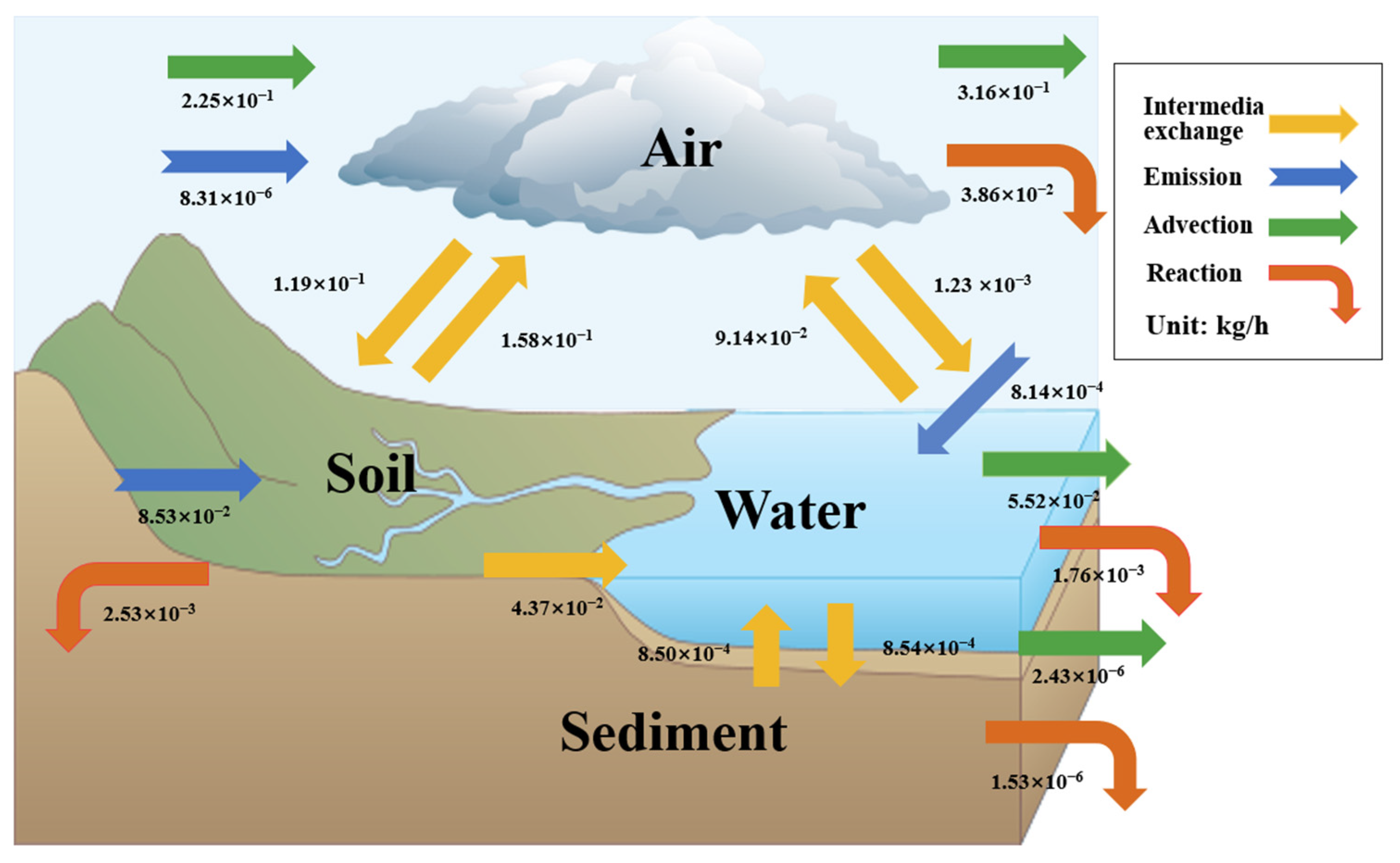


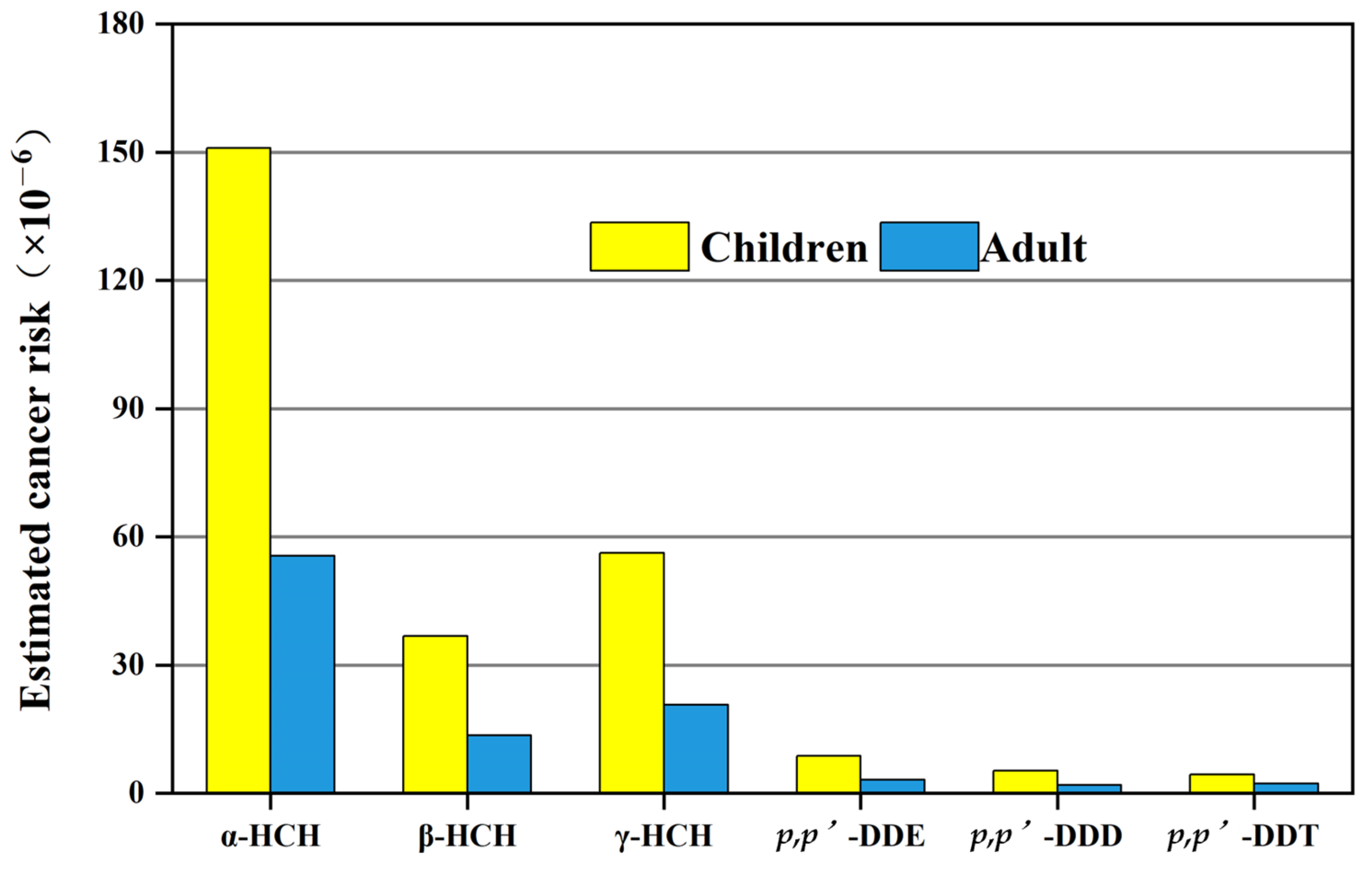
| Location of Districts and Counties | Frequency (%) | Mean (μg kg−1) | |
|---|---|---|---|
| Haiyan | Upstream | 0.00 | 0 |
| Huangyuan | 33.30 | 0.77 | |
| Datong | 37.10 | 0.99 | |
| Huzhu | Midstream | 10.00 | 0.34 |
| Urban areas | 50.00 | 1.1 | |
| Huangzhong | 33.30 | 1.71 | |
| Minhe | Downstream | 23.50 | 1.81 |
| Pingan | 66.70 | 2.77 | |
| Ledu | 53.80 | 1.95 | |
| Whole basin | 31.80 | 1.22 | |
| Frequency | Range | Mean | |
|---|---|---|---|
| (%) | (μg L−1) | (μg L−1) | |
| α-HCH | 26.67 | ND-0.75 | 0.11 |
| γ-HCH | 13.33 | ND-1.6 | 0.15 |
| β-HCH | 6.67 | ND-0.64 | 0.04 |
| δ-HCH | 13.33 | ND-0.59 | 0.06 |
| p,p′-DDE | 40 | ND-0.8 | 0.15 |
| o,p′-DDT | 13.33 | ND-0.69 | 0.07 |
| p,p′-DDD | 13.33 | ND-0.57 | 0.06 |
| p,p′-DDT | 13.33 | ND-1 | 0.09 |
| Environmental Phase | Measured Value | Simulated Value | Data Sources |
|---|---|---|---|
| Air | 672 (pg m3)−1 | 621 (pg m3)−1 | The literature |
| Water | 0.15 μg L−1 | 0.08 μg L−1 | Determination in the laboratory |
| Soil | 1.06 μg kg−1 | 0.10 μg kg−1 | Determination in the laboratory |
| Sediment | 0.07 μg kg−1 | 0.04 μg kg−1 | The literature |
| Migration Flux | Transport Rate |
|---|---|
| Air to water | 1.23 × 10−3 |
| Air to soil | 1.19 × 10−1 |
| Water to air | 9.14 × 10−2 |
| Water to sediment | 8.54 × 10−4 |
| Soil to air | 1.58 × 10−1 |
| Soil to water | 4.37 × 10−2 |
| Sediment to water | 8.50 × 10−4 |
| Air advection | 3.16 × 10−1 |
| Water advection | 5.52 × 10−2 |
| Soil advection | - |
| Sediment advection | 2.43 × 10−6 |
| Air reaction | 3.86 × 10−2 |
| Water reaction | 1.76 × 10−3 |
| Soil reaction | 2.53 × 10−3 |
| Sediment reaction | 1.53 × 10−6 |
Disclaimer/Publisher’s Note: The statements, opinions and data contained in all publications are solely those of the individual author(s) and contributor(s) and not of MDPI and/or the editor(s). MDPI and/or the editor(s) disclaim responsibility for any injury to people or property resulting from any ideas, methods, instructions or products referred to in the content. |
© 2023 by the authors. Licensee MDPI, Basel, Switzerland. This article is an open access article distributed under the terms and conditions of the Creative Commons Attribution (CC BY) license (https://creativecommons.org/licenses/by/4.0/).
Share and Cite
Yu, R.; Zhou, Y.; Xu, S.; Jing, J.; Zhang, H.; Huang, Y. Distribution, Transfer, and Health Risk of Organochlorine Pesticides in Soil and Water of the Huangshui River Basin. Toxics 2023, 11, 1024. https://doi.org/10.3390/toxics11121024
Yu R, Zhou Y, Xu S, Jing J, Zhang H, Huang Y. Distribution, Transfer, and Health Risk of Organochlorine Pesticides in Soil and Water of the Huangshui River Basin. Toxics. 2023; 11(12):1024. https://doi.org/10.3390/toxics11121024
Chicago/Turabian StyleYu, Ruyue, Yang Zhou, Shengxian Xu, Jing Jing, Hongyan Zhang, and Yuanfang Huang. 2023. "Distribution, Transfer, and Health Risk of Organochlorine Pesticides in Soil and Water of the Huangshui River Basin" Toxics 11, no. 12: 1024. https://doi.org/10.3390/toxics11121024
APA StyleYu, R., Zhou, Y., Xu, S., Jing, J., Zhang, H., & Huang, Y. (2023). Distribution, Transfer, and Health Risk of Organochlorine Pesticides in Soil and Water of the Huangshui River Basin. Toxics, 11(12), 1024. https://doi.org/10.3390/toxics11121024






